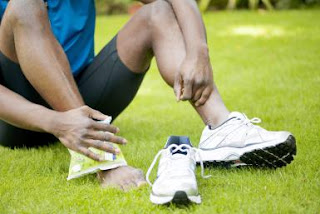How To Treat Ankle Tendon Injuries
I have seen people limp
into the gym with a bandaged ankle, but still go on the stepper, grimacing and
grunting as they step up and down. When asked why the ho and ha, during a
workout. In other words, why continue to stress the affected ankle further. The
normal response is ‘Oh I want to work through this pain. If I rest it, it will
get worse’. No it won’t, so say the experts.
The fact is that strained
or torn tendons in the ankle may occur without a painful injury. What this
means is that the person did not twist or roll the ankle and the pain just started
without any warning. The injury can be from putting too much pressure on the
tendon or just a natural deformity of the tendon. There are two large tendons
in the ankle: the peroneal tendon
which runs along the outside of the ankle and the posterior tibial tendon which runs along the inside of the ankle. The
focus will be on how to recognise the symptoms of injury on the posterior tibial tendon and treat it.
It was in the early
evening, and Frank decided to join his kids in rope skipping. It was a good
excuse to leave his laptop after four grueling hours trying to finish a
business proposal. True he had not done much exercise lately, but the need to
stretch his legs and move his body was so tempting. In any case, he had read
that rope skipping is a great exercise, so Frank was enthusiastic to
demonstrate his fitness. He was doing very well and got the pace up to double
time. He was even introducing new dimensions, like rope cross overs, to the
skipping. Frank finished rope skipping, handed the rope to his daughters and
proceeded to walk away. But when Frank took a step with his left foot, he
almost fell over from the pain on the inside of his left ankle. He limped back
into the house by putting all his weight on the outside of his left foot.
Frank assumed it was just
one of those pains that would fade away; as such he didn’t go to seek medical
attention immediately. By the third day, a large swelling developed that kept
growing for the next week. The pain when Frank walked was not so intense but
really painful when he pushed anything or had to pick up and move heavy items.
When it became unbearable, Frank finally went to the doctor a week after the
injury. Fortunately the x-rays were negative for a fracture. The doctor made Frank
stand on one foot. Frank could stand on his right foot without a problem, but
when he tried to stand on his left foot, it was sheer agony.
The doctor decided to treat
the symptom with RICE therapy, acronym for rest, ice, compression, and
elevation, and in addition prescribed a non-steroidal anti-inflammatory. Frank
was given an air cast and told to put his ankle out of action for three weeks.
During those three weeks he also had to do rehabilitation exercises twice a
day. By resting his ankle together with the rehabilitation, the tendon was
strengthened while preventing it from any further injury to it.
Frank’s experience is not
peculiar to ankles and to men. The advice is that pain in any part of the body,
irrespective of your gender, should not be left untreated for too long. So next
time you have an injury that’s sport related and hoping the pain will
eventually go away, it may or may not. Your best bet is to have the injury
checked out by your doctor.
Photo Credit: Creative
Commons






Comments
Post a Comment